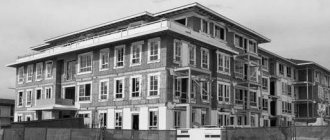All lands in Russia are divided into zones and territories, which are taken into account when determining the types of their use for development planning. One of the key regulations that enshrines zoning is the rules of land use and development. In the capital, such an act is regulated by Resolution No. 120-PP.
Get an estimate of the cost of this service using our price calculator - here
What are PZZ and GPZU, how to obtain these documents, what options exist for making changes to the PZZ - more details in the article.
When using this material, an interactive link
the source is required © “Chairman of the Homeowners Association”
Alina Engalycheva
Before talking about the current situation with the design and registration of a land plot of an apartment building in Moscow, it is necessary to mention the Moscow Land Use and Development Rules (LRU) adopted in 2021. Next, we will find out how the urban planning document - PZZ - can influence our property rights as owners of land plots.
History of Moscow PPZ
Despite the fact that the current General Plan of the capital was adopted in 2010, until 2021 Moscow lived without approved PZZs.
Changes were constantly made to federal legislation, pushing back the deadline for the mandatory adoption of PZZ - first to 2014, then to 2021, and finally to 2021.
Why did they push it back? Because in the absence of a land plot, it was allowed to provide land plots for construction as God dictated. Or not God. Or not to the soul.
Both the General Plan of the city and the PZZ were previously approved by city law - public hearings had to take place, after which the Moscow City Duma had to adopt the corresponding law of the city of Moscow.
In Moscow, public hearings on the General Plan were held simultaneously with hearings on the PZZ - in 2009, after which in 2010 the General Plan passed through the Moscow City Duma and became Moscow City Law No. 17 “On the General Plan...”. And after public hearings, the Law of Laws received many comments and had to be adjusted, and they were prepared for the second reading in 2013.
The second edition of the Moscow PZZ was prepared in 2013, and did not differ from the first. But even in this form, without eliminating the comments, the second reading did not happen in the Moscow City Duma - the draft remained a draft and did not become a Law. Land plots for construction continued to be allocated on the “take it or leave it” principle, the living space and property of Muscovites (land resource) melted away like shagreen skin - the invasion of infill development inside residential areas acquired the scale of a natural disaster, circumventing the law became easy and simple - the procedures became "spent".
Despite the norm that has been in force all this time (it is still in force) of the Moscow Urban Planning Code, according to which land use and development rules, territory planning documentation that do not comply with the General Plan of the City of Moscow are not subject to approval, and those approved are not subject to application in the relevant part (p .4 part 1 article 4) - planning projects were approved arbitrarily, and the adopted PZZ, which included all the urban planning documentation that violates the General Plan, runs counter to the General Plan.
The master plan of the capital has turned from a strategic planning document into an indulgence.
Simultaneously with this change in legislation, the status of the PZZ was lowered - instead of a city law, the PZZ is approved by a by-law (in Moscow, the PZZ is now approved by a resolution of the city government).
And in 2021, the PZZ in Moscow was approved - the corresponding Resolution of the Moscow Government No. 120-PP dated March 28, 2017 was issued. The adopted PZZs have nothing in common with the previous PZZ projects of 2009 and 2013, and legalize a lot of odious urban planning decisions made in recent years after the approval of the last General Plan, which is also, to put it mildly, very far from perfect.
The specifics of Moscow PZZs are a separate story; we will dwell on this a little lower, because PZZs today are not a help, but an obstacle to the registration of land plots of MKD.
"Dancing with Tambourines"
The complexity of land legislation, as well as issues of property rights to land, have been little studied by our fellow citizens, and it is quite difficult for a mere mortal to comprehend all the depths of this layer of laws. But everything can be understood from a simple axiom: not a single house has ever been built - neither in Soviet times, nor in pre-Soviet, nor in post-Soviet times - without providing a plot of land for this house, otherwise it is unauthorized construction, illegal construction .
Therefore, if we talk about the overwhelming majority of houses in Moscow that were built precisely during the Soviet period, all land plots of these houses fall under the term “previously registered objects”, the rights to which the owners received from the previous owner when the right to an apartment in such a house was transferred to the procedure for privatization (that is, during the transition from state ownership to private ownership).
Documents for previously registered objects are recognized as valid - as established by federal legislation (Article 45 of Federal Law No. 221-FZ, Article 69 of Federal Law No. 218-FZ).
At the same time, there is a constant “dancing with tambourines” around the land plots: we are told that while the plot is not registered in the cadastral register, it has not become our property and remains the property of the city (Article 16 of Federal Law No. 189-FZ) . At the same time, terms are used that are not currently defined in legislation (for example, “formation of a land plot”).
However, according to the explanations of paragraph 67 of the joint Resolution of the Plenum of the Supreme Court of the Russian Federation and the Plenum of the Supreme Arbitration Court of the Russian Federation dated April 29, 2010 N 10/22 “On some issues arising in judicial practice when resolving disputes related to the protection of property rights and other property rights rights"), the owners of a house whose plot is not registered have exactly the same rights to the land plot as the owners whose plot is registered.
But in Moscow there is a constant change in the boundaries of land plots of apartment buildings through the development and approval of land surveying projects, which are developed under government contracts by the Department of City Property. And citizens under these projects are, as it were, re-allocated with plots of land. At the same time, since 2015, a norm has been in force (Part 3 of Article 11.3 of the Land Code of the Russian Federation) that sections of apartment complexes can be formed exclusively in accordance with the land surveying project. You just need to take into account that this norm should not apply to previously registered areas (registered by the state even before the cadastre appeared in cities).
In today's land surveying projects, as a rule, the previous boundaries of plots are not taken into account, which in many cases leads to a violation of the property rights of owners, since parts of their property - land plots - are confiscated from them. This is in violation of the current direct prohibition, which is established by the Decree of the State Construction Committee of the Russian Federation dated October 29, 2002 N 150 “On approval of the Instructions on the procedure for the development, coordination, examination and approval of urban planning documentation” (clause 3.2.2. Territory land surveying project), according to which the boundaries Existing land uses during the development of a land survey plan are not subject to change, with the exception of cases of seizure of land for state and public needs in accordance with the law or with the consent of the land user to change the boundaries of land plots. Owners who do not express their objections during public hearings and do not substantiate them properly, and after approval of the land surveying project - agree with it, as evidenced by their actions to form and design a new site for their house, fall under this exception - consent of the land user to change boundaries when developing a land survey plan.
Whether it’s good or bad, right or wrong – let’s leave it out of the question. One way or another, the owners of many houses design the site according to the land surveying project. And here, for some time now, another unpleasant surprise awaits them.
Moscow "mulka"
When the draft PZZ was presented to the public in December 2016, it was subject to serious, justified criticism. We will not dwell on all the shortcomings of these PZZs - we will present a very accurate, in our opinion, conclusion by Professor of the Higher School of Urbanism E.K. Trutnev, made after studying the project of the Moscow PZZs (URBAN.HSE.RU):
“CONCLUSION:: through the Moscow PZZ project and under its camouflage veil, an opportunity is being prepared, open to any interested parties and the administration, supported by regional pseudo-legislation, in an individual, unformalized and virtually uncontrollable manner for the public to carry out targeted intrusions into the existing structure of the city at any point. , contrary to declarations to the contrary - to produce practically unchanged everything that was carried out in the city through the system of point-administrative urban planning over the last quarter of a century, but now under the nominal cover of the distorted, practically abolished institution of urban zoning in violation of federal laws. The fact of the presence of the evidence presented above that the draft document contradicts the declarations proclaimed in it regarding the stability of development, and also contradicts federal laws, makes it impossible to carry out the legal procedures for the adoption of such a draft PZZ of Moscow.”
Nevertheless, the PZZs were accepted - “without noise and dust.” Many Muscovites then underestimated the legal consequences of adopting such PZZs.
What problems do owners in Moscow face after the adoption of the PZZ when registering a land plot for a land surveying project?
Let's assume that you have registered a land plot in the cadastral register, having formed it according to a land surveying project. At the same time, the site does not have an address and type of permitted use (UR).
Before the adoption of the PZZ, VRI was assigned by the relevant Order of the Moscow City Property Department (DGI), which was approved upon the application of the owner of the premises in the apartment building as part of the provision of public services. But after the adoption of the PZZ, these orders are not accepted by Rosreestr as a basis for assigning VRI. And formally, Rosreestr is right.
Let's look at this using one example of such a suspension.
Position of Rosreestr:
— the land plot, according to the PZZ of the city of Moscow, is located in a zone with the index “F” (note: an unprecedented designation of the zone, invented by the “virtuosos” of Moscow);
- in accordance with clause 3.3.2 of the Land Use and Development Rules of Moscow, in all territorial zones of preserved land use (actual use - index “F”), types of permitted use are established as the main types of permitted use of land plots and capital construction projects, information which are contained in the Unified State Register of Real Estate;
- according to the Unified State Register of Real Estate, the land plot has not been identified;
— amendments to the PZZ are required.
Further, Rosreestr explains that the establishment and change of the VRI of a land plot is carried out on the basis of a decision of the authorized government body only in cases provided for in clause 3, part 1 of Art. 4 of Federal Law No. 191-FZ “On the introduction into force of the Town Planning Code of the Russian Federation”, the provisions of which are temporary and cease to apply if the PZZ is adopted. (Indeed, before the adoption of the PZZ, the VRI was established in exactly this way - by the Order of the DGI, as indicated above).
We note that this procedure for assigning types of use of land plots, which is specified in clause 3.3.2 of the Moscow PZZ (based on information from the Unified State Register of Real Estate, which many plots do not have), contradicts Part 4 of Article 37 of the Town Planning Code of the Russian Federation, which establishes independence rights holders of land plots and capital construction projects in the selection of main and auxiliary types of use from those established in relation to the territorial zone.
The procedure currently in force confronts new owners with an impossible task when, after state cadastral registration, the land plot does not have an address and type of permitted use, which they themselves, as owners, can, according to the law, choose, but they have nothing to choose from, so As a regulation, in fact, it is not established.
But the problem is that the Moscow PZZ contains a list of types of permitted use that does not comply with the requirements of federal legislation.
In accordance with paragraph 2 of Art. 7 of the Land Code of the Russian Federation: “Types of permitted use of land plots are determined in accordance with the classifier approved by the federal executive body exercising the functions of developing state policy and legal regulation in the field of land relations.” This classifier (hereinafter referred to as the Federal Classifier) was approved by order of the Ministry of Economic Development of the Russian Federation dated September 1, 2014 No. 540, and came into force 90 days after adoption. From now on, in official urban planning and land documentation, in particular in territorial planning documents, only the types of permitted uses contained in the Federal Classifier can be used. Federal laws do not provide for the powers of subjects of the Russian Federation to make changes to the types of permitted use (in their name, description or code (numerical designation), as well as to establish in regional regulatory legal acts any other types of permitted use (by name, description or code (numerical designation) than those provided for by the Federal Classifier.
In the Moscow PZZ, the VRIs do not correspond to the federal classifier - they are formed by adding additional numbers to the VRIs contained in Order of the Ministry of Economic Development No. 540.
Since the right to determine the VRI belongs exclusively to the federal body (the Ministry of Economic Development of the Russian Federation), the “amateur activity” of the executive body of the subject, among other things, violates the Federal Law of October 6, 1999 N 184-FZ “On the general principles of the organization of legislative (representative) and executive bodies of state power subjects of the Russian Federation" (Part 2 of Article 3) and is an abuse of official power.
We emphasize that this position is reflected in the response of the Ministry of Economic Development.
What is the answer from Moskomarkhitektura, the creator of the wonderful PZZ of Moscow?
Moscomarchitecture, as always, is unperturbed:
Position of the Moscow Committee for Architecture:
- Urban Planning Code in Part 6 of Art. 30 prescribes in the town planning regulations within the relevant territorial zone to indicate the types of permitted use of land plots and capital construction projects ;
— The Land Code establishes that the types of permitted use of land plots are established in accordance with the classifier approved by the federal body;
— the classifier of types of permitted use of land plots was approved by Order No. 540 of the Ministry of Economic Development;
— at the same time, the federal classification of types of permitted use of capital construction projects has not currently been approved, so we came up with our own vision;
- the law has not been violated, since the PZZ establishes the types of permitted use NOT of “land plots” , but of “land plots and capital construction projects” .
SMART? What about - Professionals in their field!
Now tell me, how can you use these PZZs? And for what purpose are they made as such? They do not protect the rights of citizens in any way.
DGI position
By the way, at one of the personal receptions at the DGI, citizens just raised the issue of PZZ in order to find out the position of the DGI. The answer was something like this: this is a defect of the Moskomarkhitektura, not our question - you make complaints against them, let them sort it out themselves.
Legal vacuum
Another interesting thing is this: how is the issue resolved in Rosreestr with the assignment of VRI to land plots of apartment buildings in Moscow?
Based on the reports of citizens, we state: there is no systematic approach .
There are several options for the development of events. For example, the following are known:
— Rosreestr does not enter the VRI according to the Order of the DGI, because it is necessary to make changes to the PZZ (the most common option);
— Rosreestr enters the VRI according to the Order of the DGI, while the VRI corresponds to the federal classifier (rarely);
Rosreestr enters VRI that does NOT correspond to the federal classifier - taken from amateur VRI of Moscow PZZ (despite the ban on the use of such VRI, set out in the above letter from the Ministry of Economic Development, which is the higher authority of Rosreestr);
— Rosreestr enters the VRI at the request of the owners, which indicates the VRI from Order No. 540 of the Ministry of Economic Development - obviously, the mechanism of Part 4 of Article 37 of the Town Planning Code of the Russian Federation is triggered (extremely rarely).
Here, for example, is the text of one of these statements:
Why is VRI needed? We are only interested in the treasured phrase, which must be included in the “Special Notes” detail of Section 1 of the extract from the Unified State Register of Real Estate for the MKD land plot: “Common property of the owners of premises in an apartment building.” And Rosreestr may not be able to enter this sacramental phrase without assigning a VRI and an address to the land plot. Or maybe write it in. Here, too, it’s “how you get there” - there is no systematic approach .
Finally, let us dwell on the amendments to the PZZ, which are most often required by Rosreestr.
Amendments to the PPL must go through a public hearing procedure, which makes the prospect very vague.
But there is a procedure for “bringing into compliance” provided for in paragraphs. 12, 13 art. 34 of the Federal Law “On Amendments to the Land Code of the Russian Federation and certain legislative acts of the Russian Federation” dated June 23, 2014 N 171-FZ, which does not require public hearings:
— 12. Until January 1, 2021, the local government body of the settlement, the local government body of the urban district are obliged to make changes to the rules of land use and development in terms of bringing the types of permitted use of land plots established by the town planning regulations in accordance with the types of permitted use of land plots provided for by the classifier of types of permitted use of land plots. At the same time, holding public hearings on the draft changes made to the rules of land use and development is not required.
— 13. Upon the application of the right holder of a land plot to establish compliance of the permitted use of the land plot with the classifier of types of permitted use of land plots, the state authority or local government body authorized to establish or change the types of permitted use of the land plot must make a decision within one month from the date of receipt of such an application on establishing correspondence between the permitted use of a land plot specified in the application and the type of permitted use of land plots established by the classifier of types of permitted use of land plots. This decision is the basis for making changes to the information of the state real estate cadastre on the permitted use of the land plot.
Thus, the primary complaints against the Moscow PZZ, which were repeatedly sent to developers and supervisory authorities, being then ignored, have been confirmed in life: this is an absolutely non-working tool, according to these PZZ anything can be done, these are actually not rules, but an indulgence for development of the capital without rules, which in no way protects the property rights and legitimate interests of Muscovites. Any action requires changing these PZZs, which are essentially just a dummy and a screen. Standing in the way of everyone who wants and has every right to register their rights to an MKD land plot in Moscow, the Moscow PZZs have erected an impregnable wall, which is extremely difficult to overcome.
- Tags:
- land plot
- Land use and development rules
- master plan
- types of permitted use
- cadastral registration
The procedure for preparing a PPP
Local rules for development and land use are developed in accordance with Art. 31 GrK. They can be created in relation to all territories of a municipal settlement or its parts, taking into account:
- provisions of the general plan of the city or settlement;
- terms of technical documentation;
- issues of public discussions and public hearings.
The decision to develop a PZZ within a populated area is made by the head of the local administration, who determines the stages of development of the PZZ, the procedure and timing of preparatory work.
Simultaneously with the decision to develop the Rules, the head of the administration establishes the composition and regulations of the activities of the commission for the development of the PPP. She will also be the initiator of public discussions on the project being developed.
After 10 days, the decision made is published on the administration’s website or distributed in other media. The decision notice also states:
- composition of the commission for the preparation of the PPP;
- stages of implementation of zoning of territories of a settlement;
- procedure and preliminary deadline for developing the draft Rules;
- rules for sending proposals from interested parties to the commission and other important information.
After the development of the draft Rules, the local government body checks them for compliance with the master plan and technical regulations.
The approved project is sent to the head of the settlement, and if inconsistencies are found, it is returned to the commission for revision.
The head of the settlement, within 10 days from the receipt of the draft Rules, schedules a public discussion of it. The procedure for conducting discussions is also established at the local level, its duration is 2-4 months.
Based on their results, the commission makes the necessary changes to the project, after which it again sends it to the mayor or other official heading the administration. He decides within 15 days whether to send the project for approval by the local council or return it for revision.
Difficulties in formalizing land legal relations in the city
More than 80% of the city territory is a zone of preserved land use, in which property rights holders do not have the opportunity to formalize land legal relations with the city administration (if the land plot has not been registered earlier). In zones with the “F” index, it is impossible to change the types of uses for new areas without amending the PZZ.
Changes to the PZZ must fully comply with the interests of city residents, take into account the features and capabilities of the existing infrastructure, and also contribute to its development. Changes made to the PZZ should create positive dynamics for developers and other persons, ensure improvement of territories, contribute to the creation of new jobs, construction of social facilities, increase investment attractiveness, improve services to the population, etc.
Change of PZZ
In many cases, land plots may not correspond to the interests of land owners and tenants. This problem is especially relevant for legal entities using land and capital construction projects for commercial purposes. For example, most land plots in Moscow belong to the “F” zone, that is, they can only be used “in fact” (any construction or reconstruction is prohibited in these territories).
In order for the owner of the site to be able to use it effectively, changes must be made to the PZZ, which can be expressed in the following forms:
- changing zone boundaries;
- changing the maximum development parameters;
- installation or modification of VRI;
- changing or establishing a new territorial zone or subzone.
To amend the PZZ, the land user must submit an application and other project materials to the local government authorities, which will be considered at public hearings. The process of reviewing and making changes to the PZZ can take from six months to a year, while self-government bodies can refuse to make changes at any time.
Our specialists will help you quickly and correctly prepare all the necessary documents and represent the customer’s interests at public hearings. The extensive experience of our employees will help to significantly reduce the time it takes to consider the customer’s application and increase the chances of a favorable decision.










